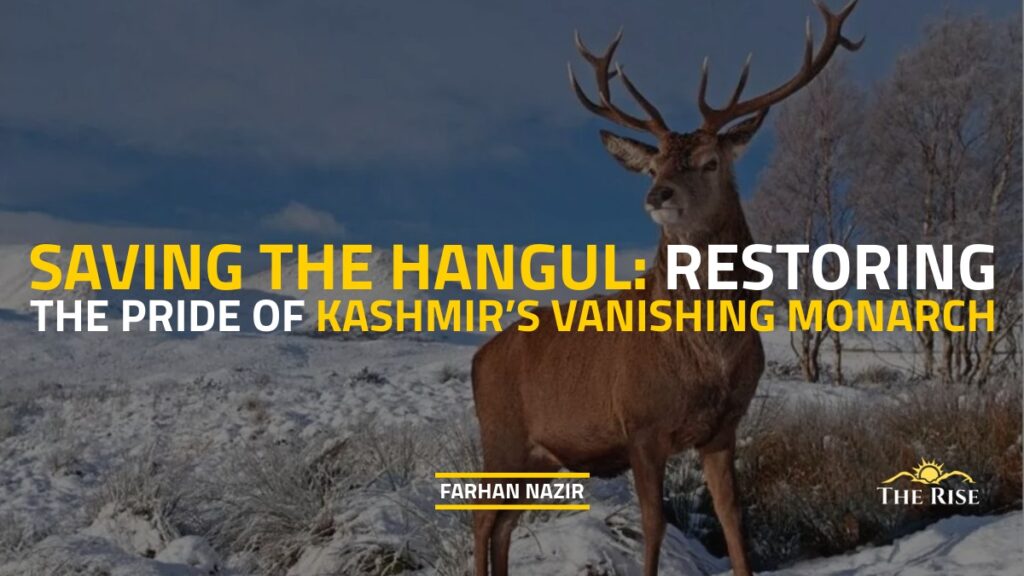To the people of Kashmir, the Hangul was not just a species — it was the spirit of the forest, the silent rhythm of nature’s harmony. Yet today, that call grows rare. The decline of the Hangul is both an ecological and emotional tragedy. Once a living emblem of the valley’s abundance, the species now stands at the brink of disappearance. Saving the Hangul is not merely an act of conservation — it is an act of remembrance, a reaffirmation of the bond between nature and identity.
At dawn, when the first rays of sunlight touch the pine-covered slopes of Dachigam National Park, the forest awakens in rhythm with the mountain wind. Mist drifts through the valleys, and from deep within the woods comes a haunting call — the call of the Hangul (Cervus hanglu hanglu), the Kashmiri stag, long revered as the Pride of Kashmir.
Once, these graceful deer roamed freely through Gurez, Sindh, Lidder, and Kishtwar, their antlers rising like living branches of Chinar trees against the Himalayan light. To the people of Kashmir, the Hangul was not just a species — it was the spirit of the forest, the silent rhythm of nature’s harmony. Yet today, that call grows rare. According to the Department of Wildlife Protection (2023), only 289 Hangul remain, confined largely to the shrinking refuge of Dachigam.
Echoes of Decline: A Silent Crisis
The decline of the Hangul is both an ecological and emotional tragedy. Once a living emblem of the valley’s abundance, the species now stands at the brink of disappearance.
The Hangul holds deep symbolic value in Kashmir’s cultural heritage — its likeness found in old tales, woodwork, and textiles. Its disappearance feels like a part of the valley’s identity fading into silence. Ecologically, it is a keystone herbivore, vital to maintaining the health of meadows and forests. Its grazing shapes the ecosystem, supporting species such as the Himalayan black bear (Ursus thibetanus) and the leopard (Panthera pardus) (Ahmad & Khuroo, 2021).
Without the Hangul, the balance of the Himalayan forest begins to unravel, and the song of life in Dachigam grows fainter with each passing year.
A Fragile Home: The Last Refuge
The Hangul’s last stronghold lies within Dachigam National Park, just outside Srinagar. Despite being legally protected under the Wildlife (Protection) Act, 1972, it remains critically endangered.
A 19-year monitoring study published in Oryx (Cambridge University Press, 2023) warned that the Hangul population has not shown any significant long-term growth, remaining below sustainable levels. Major challenges include habitat fragmentation, competition with livestock, and genetic isolation.
Also Read: Human-Wildlife Conflict Deepens in Kashmir’s Ganderbal: Monkeys and Bears Take Over Fields
The population’s skewed sex ratio — with only 27 males per 100 females — along with low calf survival rates, has severely limited its recovery.
Recent Successes: Whispers of Revival
Amidst decades of decline, the last few years have brought subtle but hopeful signs of revival. The 2023 Hangul census, conducted by the Department of Wildlife Protection in collaboration with the Wildlife Institute of India (WII), recorded a rise from 261 individuals in 2021 to 289 in 2023 — the first consistent increase in years.
Several integrated efforts have driven this progress, which includes:
- Habitat restoration, with replanting of native vegetation and the creation of freshwater sources.
- Scientific monitoring using camera traps and drone-based tracking for accurate data (WII, 2023).
- Regulation of grazing in calving zones and improved anti-poaching enforcement.
- Genetic research and conservation planning under the guidance of the IUCN (2024).
- The upward trend is modest but meaningful — proof that dedicated efforts can turn decline into resilience.
Learning from the Nilgiri Tahr: Lessons in Hope
The success of the revival strategy of Nilgiri Tahr (Nilgiritragus hylocrius) in southern India offers a blueprint for Hangul revival. Through community participation, eco-development committees, and strict habitat protection, its population rebounded from 300 to over 800 within two decades (Wildlife Institute of India, 2024).
By merging scientific research with local stewardship, a similar transformation can be achieved for the Hangul. Conservation must no longer be a policy on paper but a partnership between people and the landscape.
The Path Ahead
To restore the ‘Pride of Kashmir’, conservation must evolve into a movement of connection — between nature and people, and between policy and compassion. The Dachigam–Sindh–Gurez corridor should be declared a Critical Wildlife Habitat, with steps taken to integrate Hangul conservation into Jammu & Kashmir’s Sustainable Tourism Policy. Furthermore, efforts should focus on restoring migration routes, controlling feral dogs, and reforesting degraded areas with Deodar, Kail, and Birch trees. In addition, scientific collaborations must be strengthened for genetic research, gene banking, and long-term monitoring using drones and AI-based tracking systems.
The Call of the Valley
As twilight deepens over Dachigam, the forest quietens, save for a distant, resonant cry echoing through the mist. It is the Hangul — the last monarch of Kashmir — still standing, still defiant.
Each surviving stag carries not only the legacy of its species but the memory of a land once defined by harmony between people and wilderness.
Saving the Hangul is not merely an act of conservation — it is an act of remembrance, a reaffirmation of the bond between nature and identity. And as the night settles over the valley, that faint call lingers — not a cry of despair, but a promise of endurance. The Pride of Kashmir still stands, waiting for its people to remember that the forest is incomplete without its king.
References
- Ahmad, F., & Khuroo, A. (2021). Biodiversity and Conservation in the Himalayas. Springer.
- Department of Wildlife Protection, Jammu & Kashmir. (2023). Population Assessment and Conservation Measures for Hangul.
- International Union for Conservation of Nature (IUCN). (2024). Cervus hanglu hanglu: Red List Status and Conservation Review.
- Oryx Journal (Cambridge University Press). (2023). Is the Hangul (Cervus hanglu hanglu) in Kashmir drifting towards extinction?
- Qadri, N., et al. (2022). Conservation Challenges of Endangered Himalayan Cervids. Journal of Wildlife Ecology, 14(3), 110–128.
- Rising Kashmir. (2024). Kashmir’s Hangul population hits 289 in 2023.
- Wildlife Institute of India. (2024). Status of Hangul in the Western Himalayas.
- Mongabay-India. (2023). Hangul population in Kashmir could go extinct without intervention, finds long-term study.
Farhan Nazir is an intern with TheRise
Disclaimer: The views expressed in this article are of the author solely. TheRise.co.in neither endorses nor is responsible for them. Reproducing this content without permission is prohibited.
About the author
Farhan Nazir is a passionate wildlife enthusiast and Zoology postgraduate from the Central University of Kashmir. He is deeply committed to the study and conservation of nature. With a growing interest in biodiversity protection and ecological research, Farhan strives to blend scientific knowledge with on-ground action to safeguard fragile ecosystems and aspires to build a meaningful career contributing to wildlife conservation and environmental sustainability.








